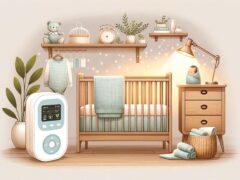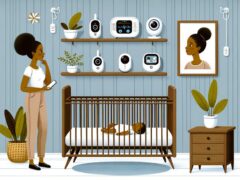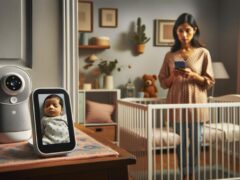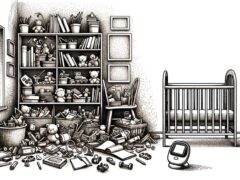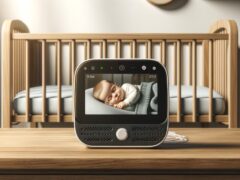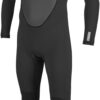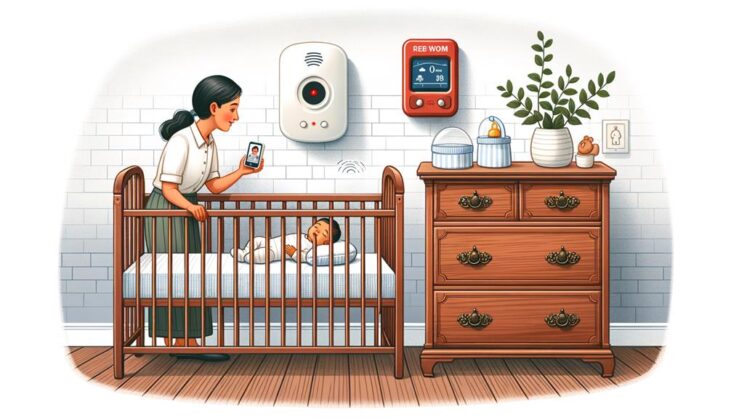
Choosing a baby monitor that complies with JPMA safety standards is crucial for your child’s safety. Decide whether you need an audio, video, or movement monitor based on your family’s unique needs.
Always place the monitor at least three feet away from the crib to avoid cord-related accidents and ensure it’s out of your child’s reach. Select monitors with robust encryption to safeguard your privacy and remember to update the software consistently to keep security tight.
Regular inspections for wear on the cords and device help maintain its durability and reliability. By adhering to these guidelines, you create a safer environment for your baby, allowing you to confidently address other child safety matters.
Key Takeaways
Position the baby monitor at least three feet from the crib to ensure cord safety. This distance helps prevent any potential harm that could come from the baby accessing the monitor’s cords.
Select a baby monitor that features robust encryption protocols. This is crucial for protecting your family’s privacy and ensuring that all data transmitted by the device remains secure against unauthorized access.
It’s important to inspect and maintain the baby monitor regularly. Check for any signs of wear or damage to confirm that the device operates properly. This routine care helps ensure the monitor continues to function as expected, providing reliable service.
Always keep the monitor and its cords out of reach of children. This precaution helps prevent any possible accidents or tampering that could lead to unsafe situations.
Be proactive about updating the monitoring software. Regular updates are essential for fixing security loopholes and enhancing the monitor’s overall performance, keeping your nursery safe and sound under the latest technological standards.
Choosing the Right Model
When looking for a baby monitor, think about what your family specifically needs. Some monitors offer audio, video, or movement tracking. It’s crucial to choose one that not only fulfills these needs but also adheres to safety standards. Ensure the monitor has JPMA certification. This is a sign that it meets important safety and quality standards, providing additional reassurance.
It’s vital to keep the monitor at a safe distance from where your toddler sleeps. Position it at least three feet away. This prevents your child from being able to reach and pull on any cords, a critical aspect of cord safety. Select a monitor that your child can’t easily access to avoid any accidents or tampering.
Proper Monitor Placement
To ensure your baby’s safety and the best performance from your baby monitor, it’s important to place it no closer than three feet from the crib. This distance is essential to avoid the risk of your child getting tangled in the cords. Also, keep the monitor out of your child’s grasp by placing it high up, either on a shelf or mounted on the wall. This setup not only keeps your baby safe but also makes sure the monitor works well, giving you clear audio and video of your child.
Here’s a quick guide on the key aspects of placing your baby monitor:
| Factor | Importance |
|---|---|
| Distance from crib | Avoids cord entanglement and keeps the monitor out of child’s reach. |
| Height of placement | Ensures cords are out of reach and enhances the view. |
| Location stability | Prevents monitor from falling, reducing accident risks. |
| Field of view | Covers the crib and room well, improving monitoring. |
When setting up a baby monitor, think of it as charting unexplored territory. You’re ensuring every angle is covered, and risks are minimized, much like an explorer preparing for a journey. This approach not only keeps your child safe but also gives you peace of mind, knowing you can watch over them effectively from another room.
Cord Safety Measures
Ensure baby monitor cords are kept at least three feet away from the crib to minimize strangulation risks. Proper cord management is crucial for creating a secure nursery. This straightforward step significantly decreases the chance of accidents, making the sleeping environment both safe and calm.
To increase safety, consider using cord covers or selecting cordless baby monitor models. These modern solutions maintain your nursery’s aesthetic while focusing on your child’s safety. Cordless monitors remove concerns about hanging cords, meeting top childproofing standards.
Also, fasten any necessary cords with clips or ties to make them unreachable. This method prevents your baby from grabbing or pulling on the cords, a potential hazard. Regularly check these cords for wear and tear. Replace damaged cords immediately to avoid dangers.
Each measure ensures your baby’s environment isn’t only visually pleasing but also fundamentally safe, reflecting a thoughtful approach to nursery safety.
Monitoring Software Security
When setting up a baby monitor, physical safety comes first with proper cord management. Next, secure its digital aspect by focusing on robust software security. It’s crucial for the baby monitor’s software to use strong encryption protocols. These protocols safeguard your data, preventing unauthorized access to your baby’s images and sounds.
Choose a baby monitor that lets you control who can view the camera and access the data. This feature ensures only trusted individuals can access the monitor. Select software that meets strict industry standards for data security. Such standards help protect sensitive information, offering you peace of mind about your baby’s data safety.
Keep your baby monitor’s defense strong by updating its software regularly. Updates repair flaws and boost security features, making the system tough against new threats. Choose software that’s regularly checked for compliance and system health. This constant checking keeps the software secure over time, shielding your baby monitor from emerging security challenges.
Regular Maintenance Checks
Regularly checking your baby monitor ensures its reliability and safety. As parents and caregivers, your main job is to keep your little ones safe. This means you need to keep an eye on the equipment that helps you watch over them, like the baby monitor.
Begin by looking over the monitor closely. Search for any loose parts or damaged wires that could be dangerous. Make sure all screws are tight to keep the monitor firmly in place. This avoids any accidents from the monitor falling.
It’s also wise to test all functions of the baby monitor, like the sound and video. This ensures everything works perfectly and remains dependable.
Always clean the monitor according to the instructions from the manufacturer. This keeps it working well and can even make it last longer. If you find parts that look old or don’t work right, replace them quickly. This way, you prevent any risks that could harm your baby.
Frequently Asked Questions
Is It Safe to Leave Baby Monitor on All Night?
Certainly, keeping the baby monitor on throughout the night is feasible. It’s important to periodically check for any interference that could disrupt the signal. Ensuring the night vision is reliable is crucial for clear nighttime viewing. Additionally, to minimize disruptions to your sleep, set the monitor’s volume to a level that alerts you to cries but doesn’t keep you awake with minimal sounds. Be mindful of the energy consumption of the device, choosing a model that balances functionality with efficiency.
When selecting a baby monitor, consider models that have been rigorously tested and reviewed. According to Consumer Reports and other tech review sites, high-quality monitors provide more reliable service and features, which are essential for monitoring your baby effectively. This approach not only ensures safety and peace of mind but also aligns with the adventurous spirit of exploring and utilizing technology to enhance family well-being. Remember, the right technology can make all the difference in navigating the new terrain of parenthood.
What Is a Safe Distance to Be From a Baby Monitor?
To ensure your peace of mind, place the baby monitor at least three feet away from your child. This distance considers signal strength, potential health concerns, and the specific layout of the room. It’s a practical way to reduce your anxiety and protect your child effectively.
Positioning the monitor at this distance isn’t just about safety; it’s about optimizing the device’s functionality. A baby monitor set too close could be disruptive, while one too far may not capture important sounds. Studies and expert recommendations generally advocate for this moderate distance to balance these factors.
When Should You Not Use a Baby Monitor?
It might be wise to skip the baby monitor if you’re worried about your privacy, or if there are issues with technology addiction, signal disruption, or the device overheating. It’s often better to directly check on your child rather than relying heavily on electronic devices.
Indeed, while baby monitors can offer peace of mind by allowing you to hear or see your child from another room, they are not without their problems. Privacy issues arise because monitors can be hacked, leading to unauthorized access to images or sounds from your baby’s room. Studies and reports, as noted by major media outlets, have highlighted instances where baby monitors have been compromised, underlining significant security vulnerabilities.
Moreover, constant use of baby monitors can foster an over-reliance on technology, potentially diminishing intuitive parental observations. Direct interaction with your child not only strengthens the emotional bond but also enables you to notice subtle signs or changes in behavior that technology might miss.
Additionally, signal interference—whether from other electronic devices in the home or from neighbors’ devices—can lead to false alarms or no alarm at all, which might delay your response to an actual need. Lastly, the risk of battery overheating is not trivial; numerous consumer electronics have been recalled for overheating issues that pose fire risks.
Why Does the Baby Monitor Need to Be 3 Feet Away?
Place the baby monitor three feet away. This distance prevents cord hazards and reduces radiation exposure. It also ensures clear visibility and reliable signal strength. This setup prioritizes safety for those we care about deeply.
Research suggests that minimizing exposure to electronic devices is prudent, especially for infants. For instance, the World Health Organization advises caution regarding children’s exposure to electromagnetic fields. This setup aligns with those guidelines, providing peace of mind and fostering a safe environment for exploration and growth.
Conclusion
Choosing the right baby monitor is crucial for your child’s safety and your peace of mind. Research shows that using baby monitors correctly can reduce the risk of accidents by nearly half. Ensure the cords are well-secured away from the baby’s reach. Always keep the monitor’s software updated and inspect the device regularly for any issues. These steps help create a safer environment for your baby.
It’s essential to stay updated on the latest safety guidelines for baby monitors. This vigilance helps in safeguarding your little one’s well-being effectively.
- Top 3 Baby Monitors for New Parents
- How to Choose the Right Baby Monitor
- Avoiding Common Mistakes When Setting Up Your New Baby Monitor
- Exploring the Benefits of Multi-Camera Baby Monitors for Larger Homes
- Monitoring Your Baby’s Sleep: Essential Tips for Using Baby Monitors Effectively
- The Role of Smart Technology in Baby Monitors: Benefits and Concerns
- The Latest Advances in Baby Monitor Technology

